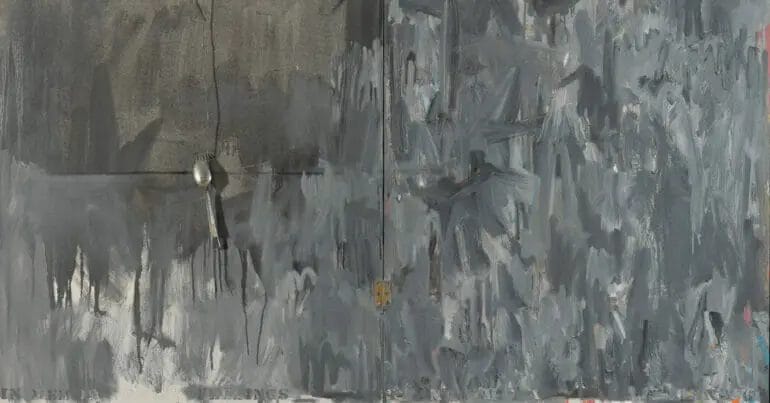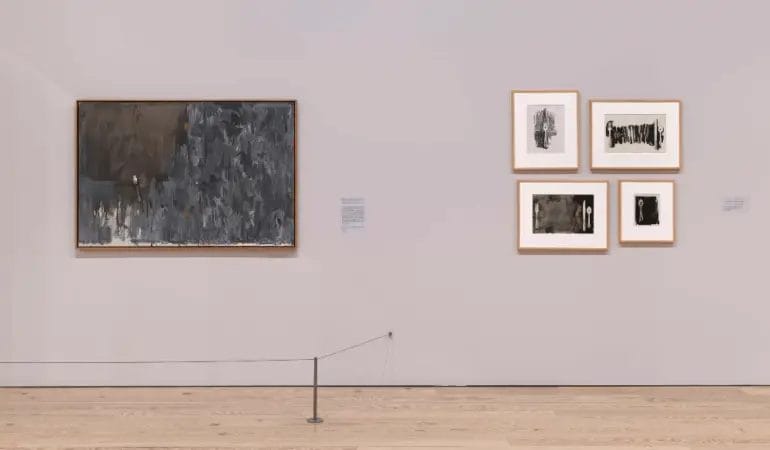A gray painting has the power to evoke deep emotions, capable of breaking your heart. In its seemingly monotonous hue lies a profound exploration of human expression. The subtle variations of gray create a hauntingly beautiful ambiance, stirring a concoction of melancholy, nostalgia, and reflection. With every stroke, the artist captures the essence of vulnerability, solitude, and impermanence. This evocative masterpiece invites you to ponder the complexities of life, bridging the gap between art and emotion. Prepare to have your heart shattered and mended by the captivating power of a gray painting.

Gray as a Symbol of Sadness: Unveiling the Heartbreaking Beauty in Art
Art has long been a powerful medium for expressing emotions and evoking deep feelings within us. From vibrant colors to delicate brushstrokes, artists have always found unique ways to capture the essence of human experiences. One such emotion that artists often explore is sadness, and they have employed various symbols and techniques to convey this complex emotion. In this section, we will delve into the use of gray as a symbol of sadness in art, unraveling the heartbreaking beauty behind this powerful expression.
The Subtle Nuances of Gray
Gray, often associated with neutrality and ambiguity, holds a unique place in the realm of emotions. It is neither black nor white, representing a state of limbo or transition. When used in art, gray can evoke a sense of melancholy, introspection, and profound sadness. Its understated presence on the canvas allows artists to delve deeper into the complexities of human emotions, inviting viewers to contemplate and empathize with the depicted sorrow.
Gray in Monochromatic Artworks
Monochromatic artworks, predominantly composed of shades of gray, offer a visceral experience of sadness. By eliminating the distraction of colors, artists can focus solely on conveying the depth of emotions through tonal variations. The interplay of light and shadow in grayscale artworks creates a haunting atmosphere, intensifying the overall sense of melancholy. These monochromatic pieces capture the essence of sorrow in its purest form, leaving a lasting impression on the viewer.
Symbolic Representations of Gray
Gray often serves as a symbol of loss, grief, and solitude in art. Artists use this color to depict desolate landscapes, abandoned structures, and solitary figures, all of which evoke a profound sense of sadness. The muted tones of gray can also convey a sense of nostalgia, representing memories faded with time. These symbolic representations of gray not only convey sadness but also evoke empathy in the viewer, allowing them to connect with the artist’s intended emotions.
Gray as a Catalyst for Reflection
Beyond its representation of sadness, gray in art can also serve as a catalyst for introspection and contemplation. The muted tones create a sense of stillness and silence, offering a space for viewers to reflect upon their own emotions and experiences. Gray encourages us to explore the depths of our own sorrows and find solace in the shared human experience of sadness. It reminds us that sadness is a natural part of life and can be a source of growth and self-discovery.
The Timeless Beauty of Gray
While sadness may be perceived as negative, the use of gray in art reveals its inherent beauty. Artists skillfully harness the power of this color to create poignant and thought-provoking artworks that speak to the depths of the human soul. The timeless beauty of gray lies in its ability to evoke a wide range of emotions, allowing us to confront our own vulnerabilities and find solace in the shared experience of sadness.
In summary, gray serves as a symbol of sadness in art, unveiling the heartbreaking beauty behind this complex emotion. Its subtle nuances, monochromatic expressions, symbolic representations, and ability to evoke reflection make gray a powerful tool for artists to convey the depths of sorrow. Through the use of gray, artists invite viewers to empathize with the portrayed emotions and find solace in the shared human experience of sadness. The timeless beauty of gray lies in its ability to capture the heartbreak and resilience that define the human condition.

The Subtle Shades of Gray: How Monochromatic Paintings Evoke Deep Emotions
In the world of art, colors play a significant role in conveying emotions and capturing the essence of a subject. While vibrant and bold hues can create a visual impact, there is something truly captivating about monochromatic paintings. These artworks, often utilizing various shades of gray, have a unique ability to evoke deep emotions in the viewer.
Monochromatic paintings are created using a single color or tone, usually variations of gray. This limited palette may seem restrictive at first, but in reality, it allows the artist to focus on other aspects of the artwork, such as composition, texture, and form. By eliminating the distraction of multiple colors, monochromatic paintings create a sense of unity and coherence.
One of the key reasons why monochromatic paintings evoke deep emotions is their ability to convey a sense of simplicity and elegance. The absence of vibrant colors forces the viewer to pay closer attention to the subject matter and the subtle details within the artwork. This focused observation allows for a deeper connection with the painting and a heightened emotional response.
Another factor that contributes to the emotional impact of monochromatic paintings is the interplay of light and shadow. Gray tones have the unique ability to create a wide range of values, allowing artists to experiment with different levels of contrast. Through skillful manipulation of light and shadow, artists can create a sense of depth and dimension, adding complexity to the artwork and evoking a variety of emotions.
In addition to simplicity and light-play, monochromatic paintings also possess a timeless quality. The absence of color makes these artworks less bound by the constraints of a specific era or cultural context. As a result, they have the ability to transcend time and speak to a universal human experience. Whether it is a serene landscape, a portrait capturing the essence of a person, or an abstract representation of emotions, monochromatic paintings have a way of evoking emotions that resonate with people across different backgrounds and cultures.
The Emotional Power of Monochromatic Paintings
Monochromatic paintings can evoke a wide range of emotions, from tranquility and serenity to melancholy and introspection. The limited color palette allows the viewer to project their own emotions onto the artwork, creating a deeply personal and introspective experience.
For example, a monochromatic landscape painting with soft shades of gray can evoke a sense of calmness and tranquility. The absence of vibrant colors allows the viewer to immerse themselves in the serene atmosphere depicted in the painting, creating a sense of peace and relaxation.
On the other hand, a monochromatic portrait with deep shadows and stark contrasts can evoke a sense of mystery and intrigue. The absence of color allows the viewer to focus on the intricate details of the subject’s expression, creating a sense of tension and curiosity.
Monochromatic paintings also have the power to evoke a sense of melancholy and introspection. The subtle shades of gray can create a somber and contemplative mood, inviting the viewer to reflect on deeper emotions and thoughts.
Appreciating the Beauty of Monochromatic Paintings
To fully appreciate the beauty and emotional impact of monochromatic paintings, it is essential to engage with the artwork on a deeper level. Here are a few tips to help you connect with these evocative artworks:
- Take your time: Spend a few moments observing the painting. Pay attention to the details, the textures, and the overall composition. Allow yourself to get lost in the subtle shades of gray.
- Reflect on your emotions: As you engage with the artwork, take a moment to reflect on the emotions it evokes in you. Does it make you feel calm, introspective, or intrigued? Allow yourself to fully experience and appreciate these emotions.
- Seek the artist’s intention: Research the artist and their approach to monochromatic painting. Understanding the artist’s intentions and creative process can deepen your appreciation for the artwork.
- Visit galleries and museums: Explore exhibitions featuring monochromatic paintings. Viewing these artworks in person can enhance your understanding and connection with the artwork.
In summary, monochromatic paintings have a unique ability to evoke deep emotions in viewers. Through their simplicity, interplay of light and shadow, and timeless quality, these artworks create a profound and introspective experience. By engaging with monochromatic paintings on a deeper level, we can fully appreciate their beauty and emotional power.

The Haunting Beauty of Gray: Captivating the Soul with Melancholic Art
Art has the power to evoke emotions, stir the soul, and transport us to another world. While vibrant colors often dominate the art scene, there is a certain allure to the subtle and muted tones of gray. Gray holds a unique place in the world of art, captivating viewers with its haunting beauty and melancholic charm. In this section, we will delve into the captivating qualities of gray and explore how artists use this color to evoke deep emotions and connect with the human soul.
The Symbolism of Gray
Gray is often associated with neutrality, ambiguity, and the passage of time. It represents the absence of color and can be seen as a bridge between black and white, offering a wide range of shades and nuances. The symbolism of gray varies across cultures and artistic movements, but it consistently carries a sense of mystery, introspection, and contemplation.
Gray can evoke a sense of tranquility and calmness. Its neutral nature allows it to blend seamlessly with other colors, creating a harmonious and balanced composition. Gray also has a timeless quality, often associated with age and wisdom. It can convey a sense of nostalgia and longing, eliciting deep emotions and connecting us to the past.
The Power of Contrast
One of the key elements that make gray art so captivating is the power of contrast. When used alongside vibrant colors or stark black and white, gray can create a striking visual impact. The juxtaposition of gray and bold hues intensifies the emotions and draws attention to specific elements within the artwork.
Contrast can also be achieved through the use of different shades of gray. Artists experiment with various tonalities to create depth and dimension in their works. The interplay of light and dark shades of gray can evoke a sense of mystery, adding an extra layer of intrigue to the art piece.
The Elegance of Minimalism
Gray art often embraces the principles of minimalism, focusing on simplicity and understated beauty. By stripping away unnecessary elements, artists are able to highlight the essence of their subject matter. Gray serves as the perfect backdrop for minimalist art, allowing the viewer to truly appreciate the subtle details and textures.
In minimalistic gray art, every stroke and every shade of gray carries significance. Each mark contributes to the overall composition, guiding the viewer’s gaze and evoking a sense of contemplation. The elegance of minimalism combined with the melancholic allure of gray creates a captivating experience for the viewer.
Expressing the Inexpressible
Gray art has a unique ability to express emotions and concepts that are often difficult to put into words. It can capture the intricacies of human experiences, such as solitude, introspection, and the passage of time. Gray art invites the viewer to reflect and interpret, allowing them to find their own meaning within the subtle nuances of the artwork.
Many renowned artists throughout history have used gray as a medium to explore the human condition. From the moody seascapes of J.M.W. Turner to the contemplative portraits of James McNeill Whistler, gray has been instrumental in conveying the depth of human emotions and experiences.
Summary
Gray art possesses a captivating beauty that captivates the soul and stirs deep emotions. Through its symbolism, power of contrast, elegance of minimalism, and ability to express the inexpressible, gray art connects with viewers on a profound level. The haunting allure of gray art continues to mesmerize audiences, offering a unique and introspective experience.
Tugging at Heartstrings: Understanding the Heartbreakingly Beautiful Stories Behind Gray Paintings
Gray paintings may seem simple or monotonous at first glance, but beneath their muted tones lies a world of deep emotions and captivating narratives. These artworks have the power to evoke a range of feelings and connect with viewers on a profound level.
1. Shades of Gray: Exploring the Allure of Monochromatic Art
Gray paintings, also known as monochromatic art, have a unique ability to convey a sense of tranquility, introspection, and mystery. The absence of vibrant colors allows the viewer to focus on other aspects of the painting, such as texture, composition, and the subtle variations within the grayscale spectrum.
2. The Power of Simplicity: Embracing Minimalism in Gray Paintings
Gray paintings often embrace the principles of minimalism, where less is more. This approach allows the artists to strip away unnecessary elements and distill their message to its essence. By using a limited color palette, they can emphasize the emotional impact and highlight the delicate nuances within the artwork.
3. Gray as a Symbol of Ambiguity and Emotional Depth
Gray is a color that sits between black and white, embodying a sense of ambiguity and duality. In gray paintings, this symbolism is often used to explore complex emotions and themes. The absence of definitive answers encourages viewers to engage with the artwork on a personal level, allowing their own interpretations to shape the narrative.
4. Gray Paintings as a Reflection of Human Experience
Gray paintings often reflect the intricacies of the human experience. They can capture moments of introspection, solitude, or melancholy. These artworks invite viewers to contemplate the universal themes of love, loss, longing, and resilience. Through the use of gray tones, artists can convey the depth and complexity of these emotions.
5. The Stories Behind the Gray: Unveiling the Artists’ Inspiration
Behind every gray painting, there is a unique story waiting to be discovered. Artists draw inspiration from personal experiences, memories, or societal issues. The narrative behind a gray painting can be heart-wrenching, filled with stories of resilience, grief, or the passage of time. By understanding the artist’s perspective, viewers can develop a deeper appreciation for the artwork and connect with it on a more profound level.
Gray paintings may not be flashy or vibrant, but they possess a quiet power that can move and touch people in unexpected ways. Their understated elegance and deep emotional resonance make them timeless and captivating. Next time you encounter a gray painting, take a moment to immerse yourself in its story and let it tug at your heartstrings.
FAQs
How can a gray painting break your heart?
A gray painting can break your heart by evoking a sense of melancholy and emptiness. The absence of vibrant colors and the use of shades of gray can convey a feeling of loneliness or sadness, resonating with the viewer’s own emotions and experiences.
Can colors in a painting affect emotions?
Yes, colors in a painting can affect emotions. Different colors have the power to evoke specific feelings and moods. Warm colors like red and yellow can elicit excitement or happiness, while cool colors like blue and green can create a sense of calmness or tranquility.
What is the importance of emotion in art?
Emotion plays a vital role in art as it allows artists to express their innermost thoughts, feelings, and experiences. Through evoking emotions in the viewer, art can create a deep and meaningful connection, offering a unique and personal experience that can be thought-provoking, cathartic, or inspiring.
Conclusion
In conclusion, it is truly remarkable how a simple gray painting can evoke such powerful emotions and even break our hearts. The understated elegance and subtle nuances of gray can transcend the boundaries of traditional art, leaving a profound impact on our souls.
Gray, with its ability to convey both melancholy and tranquility, speaks to the deepest recesses of our emotions. It invites us to reflect, to question, and to explore the depths of our own experiences. It stirs within us a sense of longing and nostalgia, reminding us of the fleeting nature of life and the beauty that lies in its imperfections.
A gray painting has the power to transport us to a world where words fail, where emotions reign supreme, and where the silence becomes a symphony. It speaks volumes without uttering a single word, making it a truly captivating and heart-wrenching art form.
